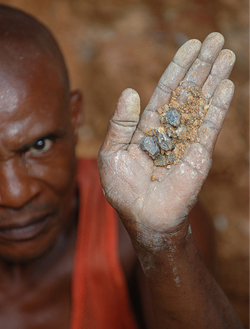
Auto makers and suppliers are scrambling to meet an expected government mandate restricting the use of so-called “conflict materials” mined in the war-torn Democratic Republic of Congo and adjoining countries.
In a letter from members of the Automotive Industry Action Group, which includes Chrysler, Ford, General Motors, Honda, Nissan and Toyota, company purchasing chiefs call on their supply base to be ready to report whether any of their components contain materials originating from the affected regions.
“These new reporting requirements reflect heightened concerns regarding the role that revenues obtained from the mining and transport of certain materials play in financing the ongoing conflict in the DRC,” says the letter, obtained by Ward’s.
Some mines in these countries use forced labor or employ underage workers, who often are exposed to unsafe conditions.
And much of the resulting revenue is used by militants to fund armed conflict, according to the Securities and Exchange Commission, which recently added the “Conflict Minerals Provision” to the U.S. Exchange Act.
The conflict minerals include coltan, niobium, tantalum, cassiterite, gold, wolframite and derivatives.
Under the ruling, to be enforced by the SEC and expected to be handed down in August, auto makers and suppliers will be required to “conclude definitively the minerals don’t come from” prohibited areas,” says Paul Laurenza, an attorney from the Washington-based law firm Dykema Gossett.
Laurenza, whose firm is assisting auto makers and suppliers prepare for the pending provision, warns tracing the origin of the banned materials will be a time-consuming and potentially expensive task and is urging clients to prepare accordingly.

“Whether you use a very small amount of a mineral or a large amount, it doesn’t relieve you of the requirement,” Laurenza tells Ward’s, noting completion of the SEC reports likely would take many man-hours.
“If you’re an auto manufacturer, imagine how many tiers of suppliers there are between the mine and the final product?” he adds.
The new legislation also is confusing, he says, because it applies to minerals necessary to the functionality or production of the final product.
“Is the audio equipment necessary to the functionality of the auto? That depends on how you define functionality,” he says.
The SEC is reviewing suggestions made by affected parties shortly after the legislation, part of the Wall Street Reform and Consumer Protection Act, was signed into law by President Obama in July.
While industry suggestions aren’t public, Laurenza says there is an ongoing effort to scale back the regulations, citing difficulties with source-mineral verification. Particularly difficult is tracing minerals all the way back to smelters, he says.
There has been a movement toward “conflict-free” smelters, but trade groups are saying they are not be reliable.
“The SEC says you have to make a reasonable country-of-origin inquiry, but they haven’t defined what that is,” Laurenza says. “What they’ve suggested is getting reliable written certifications from the smelters that confirm as much as reasonably possible where a mineral comes from.”
In its letters to suppliers, the AIAG suggests ways to prepare for the new legislation, including:
- Determine which parts/assemblies incorporate one or more of the identified conflict materials or their derivatives.
- Map supply chains associated with those parts/assemblies.
- Engage with suppliers to identify the smelters used to process the conflict materials or validate the origin of conflict materials as recycled/scrap.
Once the new legislation is passed, there will be a brief petitioning period before the law goes into effect, likely next year, Laurenza says.
Auto makers and suppliers then will be required to submit an annual report to the SEC or face penalties.
If auto makers and suppliers can’t conclude definitively they didn’t use minerals from the DRC area, they have to file a “full conflicts report as an exhibit to the SEC filing, and that has to be audited by a third party,” Laurenza says.
Finding substitutes for the banned materials will be difficult. Most minerals on the list are commonly used in automotive manufacturing and sourced primarily from the DRC region.



